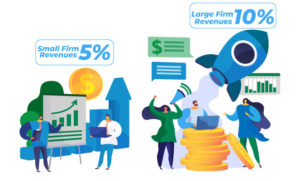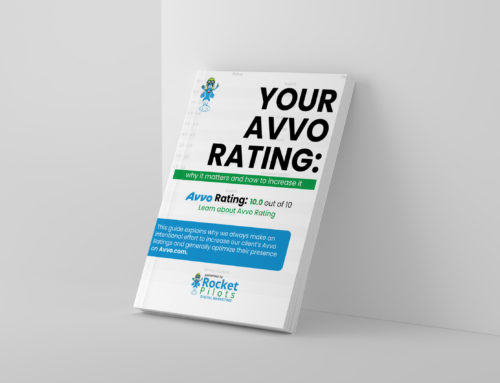Determining your law practice marketing budget isn’t always easy. Especially true when your focus is on your clients.
When deciding how to divide marketing resources, view your law practice as a small business. As with any business segment, there is no specific rule about how much money to spend. But you do need to account for the factors that influence your firm’s success.
- Type of law you practice
- Scope of your services provided
- Geographical area your firm serves
- Competitiveness of the market
You’ll also want to factor in specific goals you have for your firm’s growth. Steady and measured? Rapid upward expansion? Somewhere in between?
Figuring out your promotional dollars doesn’t need to be an abstract concept. Even if you don’t have the resources to employ a marketing department, all it takes is understanding a few basic tenets. You’ll capture current marketing needs and plan for the future. All within a budget your firm can manage.
The Average Marketing Spend for a Law Firm
On average, our San Diego law firm internet marketing company sees that law firms, regardless of their size or specialization, commits approximately 2% of annual gross revenues to marketing.
This figure fluctuates based on many factors. Law firm budgets run from shoestring to astronomical. Both can exist in the same segment within the same market.
Large national or international firms will earmark up to 5% of their annual gross revenues towards marketing. For smaller practices, the number increases to 10%.

When developing a marketing budget, consider where your firm falls within each factor. Type of law, service scope, geography, and competition.
Type of Law You Practice
Consumer-driven law firms – those that practice family or property law or personal injury or criminal defense – often allocate upwards of 10% of revenue to their marketing.
Successful personal injury firms will double this number, spending 20% on brand exposure.
Corporate law practices fall into the 2% to 5% range.
Your specific discipline may influence your marketing budget. If yours is the only family practice in town, it may not require much to get your name out there and build up your client list.
Do you practice personal injury law in an area with heavy industry? Near major transportation centers, or where laws encourage a large legal presence? That 20% number is a necessity.
Scope of Your Services
Is yours a solo practice that focuses on one area of law? Or does your firm feature multiple lawyers practicing multiple disciplines?
Depending on the answer, you could find yourself targeting clients across a wide swath of advertising sources.
Also, take into account how you approach the needs of your clients. Personal injury attorney advertising should be more immediate, single points of engagement.
If your services are greater in scope – property law or estate planning – the engagement timeframe will be longer. You’ll want to budget numerous points of engagement and regular follow-up.
Geographical Area and Competitiveness of the Market
Where you practice often proves one of the more underappreciated aspects of marketing. How much you spend in advertising to cover your service area runs parallel with market competitiveness.
As mentioned, if your firm is the only one of its specialty in an area, your advertising costs may be lower.
If your practice covers a lot of territory, or a large number of communities, expect your expenses to increase.
Narrower geographical areas might reduce your spending. But you’ll want to account for the competitiveness of the regions you cover.
Are there lots of firms that offer your specialization? Is there a large practice with several attorneys who share your focus? Does your competition include only solo practices? Mid or large-sized firms? A mix of each?
Take a close look at who your direct competitors are and the areas they service. To get noticed in a crowded market, you may need to increase your budget.
Marketing Channels
Once upon a time, this heading would have said advertising sources. A newspaper ad, a billboard, a radio or TV spot – those were the tried and true marketing avenues for attorneys as recently as a decade ago.
The digital age has led to a broader form of client acquisition and retention. A better term for it is engagement.
Billboards and TV advertising still attract a decent audience. For specializations such as personal injury or litigation, they’re almost a necessity. Individuals who seek more nuanced attorney services will take their time researching firms.
Much of that research occurs online.
Online Advertising
Digital marketing adoption rates continue to increase amongst law firms that advertise. According to one study, 65% of surveyed law firms spend over half of their marketing budget on online engagement and marketing sources.
The survey also gauged which marketing sources prove most successful. The breakdown for which avenues performed the best include:
- Lead generation services
- Search engine optimization or SEO.
- Search engine marketing such as pay per click campaigns or Google Ads
- Social media engagement
Each one of the above outlets performed better than print or phone book ads or TV ads.
The most attractive aspect of online advertising is its cost-effectiveness. You stand a greater chance of reaching a wider, more targeted audience at a lesser cost than traditional sources.
Online advertising promotes direct engagement of individuals searching for attorney services. It’s a highly successful tactic.
This includes social media and SEO. Facebook, LinkedIn, and Twitter have all become significant connection points for individuals seeking services of all kinds, including legal help.
For more information on SEO for law firms see these pages: personal injury lawyer SEO, SEO for family law, and SEO for family law.
Social Engagement
Another growing source of new business and client retention stems from your firm’s website. Your ability to network online also plays a role.

No longer are websites static – those that advertise little more than a law firm’s services and rates. Consumers expect brands to go the extra mile to earn their business. That includes attorneys and law firms.
Provide would-be prospects something of value by leveraging your expertise and creating content. Consider items such as:
- A legal FAQ
- A blog post explaining the legal specifics on various topics
- Legal webinars
- Videos posted to YouTube highlighting your field of law
Each of these holds incredible value for those seeking answers to legal issues. Even better that they get those answers from you.
Much of this content finds a home on your website and boosts your lawyer SEO. It doubles as a tool to increase your social media engagement. Insightful, original content is in high demand. Posting it on social media platforms will enhance your firm’s profile at a nominal marketing cost.
Free Advertising
Beyond paying to increase your digital presence, consider “local” online advertising. As great as Google or Facebook Ads may be, they still cost money. Look to tools such as Google Business Profile (or Apple Maps or Bing Places) to add a dynamic and free outlet to your efforts.

These sources tap into a growing trend of people searching for local businesses through map apps. When you hear the term “local search,” this is it.
The advantage is that those searching locally are motivated. They need legal services and want to retain them now. This is instead of querying general legal questions on a search engine.
Plus, the services are 100% free of charge. The only investment is time to set them up. It’s a huge plus for your marketing plan without adding expense to your marketing budget.
Legal Directories
They may not be as flashy as social media or capture an exclusive audience as your website would. Still, legal directories remain a critical channel where individuals search for and retain legal services.
Popular sites such as FindLaw, LawInfo, and Lawyers.com offer tools to help your firms get noticed and build your client roster. From a budgeting standpoint, services range from a pay-per-click model to subscription-based listings.
Here is a carefully curated list of The Top Legal Directories online.
TV and Print
Traditional as they may be, TV and print advertising (including billboard displays) still prove a useful tool. They garner lots of attention in many markets across the country.
Traditional marketing tends to be pricier than online advertising. Ensure you understand the clientele you’re hoping to reach and the goals you have for promoting your firm.
While a billboard may be adequate for specific legal segments or raising awareness, make sure it’s a channel that will garner a lead from your desired client pool. Same for TV ads. They may raise awareness but might miss the mark generating a viable amount of leads.
Building Your Client Base
When creating your law firm’s marketing budget, it’s critical first to evaluate and examine your firm’s overall goals. Generally speaking, you aim to increase your caseload by acquiring new clients.
More than just new clients, you increase your caseload through the retention of those same clients for when they require your services in the future.
- How aggressive your plan is for acquiring new clients
- Marketing channels you want to employ or that are available in your area for acquiring new clients
- Commitment to various physical marketing endeavors
- Overall growth or client acquisition strategy
Acquisition
New clientele is of particular importance for law practices. Unlike traditional businesses, like retail, where repeat customers help drive revenue, law practices can’t necessarily build their fortunes on the prospects of consistent, repeat clients.
Exceptions exist – property or tax law, for example – but the bulk of your budget should be dedicated to acquiring new clients.
As a basic rule, you should expect to spend approximately five times the amount on new clients as you spend on retention. That ratio, of course, changes based on specialization.
Regardless of how much you spend, measure your marketing success by your cost per lead. You want to ensure you’re driving traffic to your practice, but more importantly, you want to attract qualified traffic.
And you don’t want to waste the dollars you spend towards that goal. For that reason alone, identify channels that provide a combination of quality and consistency.
It’s okay to earmark funds to create awareness of your legal brand. But if those efforts don’t bring in new business, shift your resources to those that will.
Retention
Client retention for a law practice relies heavily on two basic tenets:
- A former client will again utilize your services in the future, should the need arise
- A former client satisfied enough with your services to recommend you to other individuals seeking similar
In both cases, you aim to ensure your firm’s presence is never far from a former client’s mind. You don’t necessarily need to build awareness, but instead, keep the past clients aware.
Retention is where engagement proves its worth. Social media and content creation further establish your expertise and remind past clients why they retained your services.
Also, consider email marketing as a critical tool in your marketing toolbox. A simple newsletter will keep previous clients updated on your firm’s comings and goings. It’s also an excellent spot to discuss larger legal issues your clients will appreciate.
Repurpose original content – FAQs, blog posts, videos – and craft informative emails around them. Anything useful and shareable to keep your services and expertise close at hand.
Final Thoughts
Your legal marketing budget is as complex or as simple as you want to make it. Yes, the question of how much lawyers should spend on marketing has a general answer. 2% to 10% (or upwards of 20%) of annual revenues. Each law firm must decide what combination of channels and financial commitment will work best to grow the practice.
You might favor drawing clients from a few sources. Or budget enough money to cover as many channels as possible. Regardless of your end spend, research first and uncover what amount of spending is right for you.
Examine where you practice, what you practice, and who else is practicing the same disciplines. Layout goals for growth and how much or how little you want to expand over a specific timeframe. Or be realistic about the caseload you and your team can take on.
One thing is certain – it’s never been easier to reach potential clients. You don’t need to be a marketing expert to build your legal brand. A little planning and research will ensure that whatever your marketing spend is, it’s the right amount for your firm.
If you need help with your digital marketing, feel free to reach out for a complimentary consultation today.





